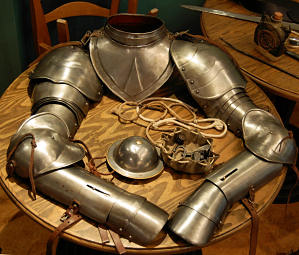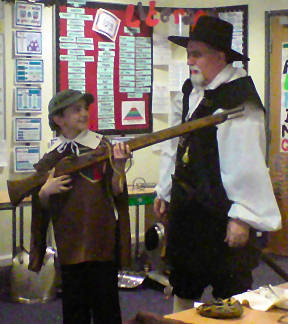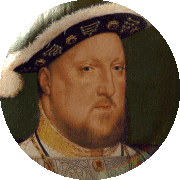Armour & Weaponry
By the end of the 16th century, armour and weaponry were advancing. The turn of the new century saw the longbow being used less and less, and ultimately replaced by the musket and other guns as the foot soldier's main weapon. Gunpowder and castles were also beginning to become a thing of the past.
Suits of Armour From the late 1500s to the early 1600s

Armour makers were making suits of armour more and more elaborate and decorative. The main factor that decided how elaborate your armour was, was how much money you had.
Full body armour could have cost you as much as the price of a small farm. At this time, full body suits of armour were reserved for royalty and nobility only.
Most full body suits of armour were made up of around eleven pieces, each having a different function. The neckpiece was called the gorget, the shoes were called sabatons, and the greave was the shin guard. The other pieces covered and protected the soldier's body. Full body armour was still being made frequently at this time, but was not used much in battle. With the introduction of new weapons such as guns and others based on gunpowder, full suits of armour were generally confined to decorative purposes only.
Soldiers and their weapons:
There were different types of soldiers in the 17th century as there are today. They each had their own armour and weapons, which they had to pay for themselves as well as their food, out of their own wages. Soldiers were not very well paid.
The Cavalrymen were soldiers that rode horses. They carried a pistol and a sword. They wore a helmet called a morion.

The Musketeers carried guns called muskets. This was a powerful weapon, the ball of which could go through armour. They did not wear any armour. Instead they wore leather coats, which could protect from a sword but could not stop a musket ball. With them, they carried a bandoleer that contained twelve wooden bottles. Each bottle contained; a charge, a flask of gunpowder and a bullet bag for his musket balls. If he ran out of ammunition, he would use his musket as a club.
The Pikemen carried long sticks (or 'pikes'), which had an iron blade at the end. The pike was extremely long, and could be anything from 10 feet to over 22 feet in length. (Between 3 and 7 metres!) Back and breastplates protected the pikeman's upper body, and his thighs were protected by pieces of armour called tassets. He wore a helmet to protect his head and large leather gauntlets to protect his hands.
A pikeman's armour was made of wrought iron. This meant it was very heavy, so only the strongest of men could be a pikeman. Infantry Officers were armed with half-pikes and had similar weapons and armour to pikemen.
The Dragoon also rode horses, but theirs were inferior to the Cavalrymen. They were armed with a short-barrelled gun called a Carbine, which they hung from a shoulder strap. They were often easy targets for enemy muskets.
Going into Battle

Going into was battle was obviously dangerous, but it was also very regimented. Everybody knew their place and their job.
A 'Pike Block' would be set up. This was a hollow square of pikemen with the musketeers in the centre of the square. The musketeers would load their muskets while in the centre of the Pike Block. On being given the order, the block would open up, the musketeers would run through, and the block would close again behind them.
Kneeling beneath the protection of the pikes, the musketeers would then be able to fire their muskets. They would then return to the centre of the block to reload their guns.
Cavalrymen attacked in ranks, six deep. They would usually be on the wings of the infantrymen where they would ride in, fire their pistols, and then retire. They were helped by the Dragoons, whose horses were not as strong as their own, therefore making them easy targets.
There was also a range of artillery devices on the battlefield that varied considerably in power. They ranged from a Culverin, which could fire 18lb (8kg) balls up to a distance of two miles, to a Robinette, that fired a 1lb (0.5kg) ball over a distance of one thousand yards.
Curriculum links:
- ART & DESIGN: Look at the materials and processes used in the art of manufacturing armour & weapons.
- HISTORY: Look at the way the advances in armour and weaponry changed the way that battles were fought.

